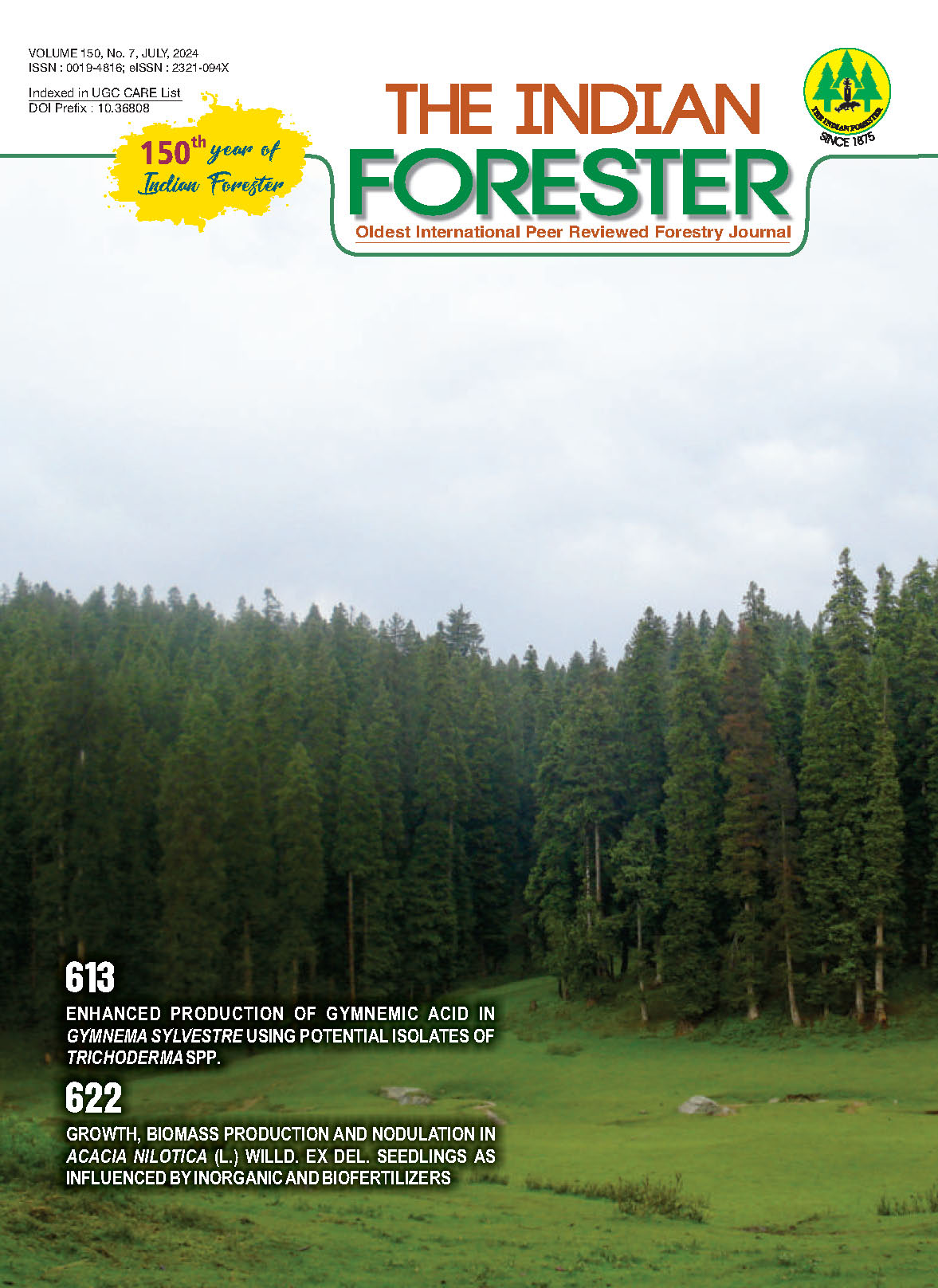Eco-Social Services of Native Tree Species: A Conservation Approach
DOI:
https://doi.org/10.36808/if/2024/v150i7/170072Keywords:
Indigenous tree, Deforestation, Medicinal value, Cultural significanceAbstract
Trees are important aspects of life on earth. The preservation and restoration of forests have always been crucial for finding answers to the climate crisis. Still, a tenth or more of the world's annual CO2 emissions is the result of 2 deforestation. Additionally, trees do much more than just storage of carbon. Additionally, they improve biodiversity, stabilise soil and other climatic conditions, cleaning, and recycling water. Deforestation by cutting down trees is advancing everywhere. In the name of development, the oldest trees are being cut down and replaced with invasive species in so many places. Awareness against the old and native tree species and their restoration should be done very quickly. Keeping this in mind, an attempt has been made to document the indigenous tree species of Odisha, India, along with their food, medicinal, economic, and mythological aspects. A survey was carried out from the year 2010 to 2023 in Odisha state under several projects and biodiversity works. Through field visits, interaction with locals, and direct observation, the information was collected. The survey revealed that trees are the lifeline of the ecosystems and are directly attached to the day-to-day work, culture, and emotions of people. These also have ecological, mythological, and cultural significance. These provide numerous services to human beings, which are documented in the paper. The present study highlights the importance of native trees and suggests planting more and more local tree species.References
Aerts R. and Honnay O. (2011). Forest restoration, biodiversity and ecosystem functioning. BMC Ecology, 24(11): 29, DOI: 10.1186/1472-6785-11-29.
Bohn F.J. and Huth A. (2017). The importance of forest structure to biodiversity-productivity relationships. Royal Soc Open Science, 4(1): 160521. DOI: 10.1098/rsos.160521.
Bradford M. and Murphy H.T. (2019). The importance of largediameter trees in the wet tropical rainforests of Australia. PLoS One, 14(5): e0208377, DOI: 10.1371/journal.pone.0208377.
Carey J. (2020). News Feature: The best strategy for using trees to improve climate and ecosystems? Go natural. Proc Natl Academy Science USA, 117(9): 4434-4438.
Das L., Mishra S., Das A., Dimri R. and Kumar S. (2022). Some common flora of temple city of Odisha, India: source for ethnomedicocultural values. Indian Forester, 148(2): 207-212.
Das M.K., Das P.K., Kumar S. and Singh N.R. (2020). Flora of Khandagiri & Udayagiri, an urban heritage of Odisha. Indian Forester, 146(6): 509-518.
Devi R.S., Kumar S. and Singh R.K. (2023). A new species of Smithia Aiton (Fabaceae) from Odisha state, India. Indian Forester, 149(4): 471-473.
Isaifan R.J. and Baldauf R.W. (2020). Estimating economic and environmental benefits of urban trees in desert regions. Urban For Urban Green, DOI: 10.3389/fevo.2020.00016.
Kumar S., Mahanti P., Singh N.R., Rath S.K., Jena P.K. and Patra J.K. (2017). Antioxidant activity, antibacterial potential, and characterization of active fraction of Dioscorea pentaphylla L. tuber extract collected from Similipal Biosphere Reserve, Odisha, India. Brazilian Journal of Pharmaceutical Sciences, 53(4): 1–10.
Mishra S. and Kumar S. (2021). Medicinal carnivorous plants of Odisha: a source of future drugs. Medico Biowealth of India VolII. APRF Publishers, Odisha.
Mishra S., Agrawal B., Rathore S., Mishra A.K. and Kumar S. (2022). Medicinal grasses of Eastern Ghats of Odisha, India. Indian Forester, 148(11): 1172-1174.
Mohan M., Rue H.A., Bajaj S., Galgamuwa G.A.P., Adrah E., Aghai M.M., Broadbent E.N., Khadamkar O., Sasmito S.D., Roise J., Doaemo W. and Cardil A. (2021). Afforestation, reforestation and new challenges from COVID-19: Thirty-three recommendations to support civil society organizations (CSOs). Journal of Environment Management, 287: 112277. DOI: 10.1016/j.jenvman.2021.112277.
Rudnev V. (2012). The factor of local cultural specificity and process of globalization. Coll Antropol, 36(4): 1135-8.
Saha M., Roy A.B., Kumar S. and Datta B.K. (2022). Ethnobotanical Diversity of some Wetland Plants of North-East India: Implications for Conservation. Indian Forester, 148(11): 1149-1154.
Saxsena H.O. and Brahmam M. (1995). The flora of Orissa: Orissa Forest Development Corporation Ltd. and Regional Research Laboratory, Bhubaneswar, Vol I-IV.
Soltis D.E. and Soltis P.S. (2019). The Value of the Tree of Life. The Great Tree of Life, 75–116. DOI: 10.1016/B978-0-12-812553-3.00005-9.
Suchocka M., Wojnowska-Heciak M., Błaszczyk M., Gawłowska A., Ciemniewska J., Jarska A., Heciak J. and Pachnowska B. (2022). Old trees are perceived as a valuable element of the municipal forest landscape. Peer J, 10: e12700, DOI: 10.7717/peerj.12700.
Wolf K.L., Lam S.T., McKeen J.K., Richardson G.R.A., van den Bosch M. and Bardekjian A.C. (2020). Urban Trees and Human Health: A Scoping Review. International Journal of Environ Research and Public Health, 17(12): 4371. DOI: 10.3390/ijerph17124371.
Downloads
Downloads
Published
How to Cite
Issue
Section
License
Unless otherwise stated, copyright or similar rights in all materials presented on the site, including graphical images, are owned by Indian Forester.





